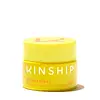What's inside
What's inside
 Key Ingredients
Key Ingredients

 Benefits
Benefits

 Concerns
Concerns

 Ingredients Side-by-side
Ingredients Side-by-side

Water
Skin ConditioningCetyl Alcohol
EmollientGlycerin
HumectantPotassium Cetyl Phosphate
EmulsifyingAvena Sativa Kernel Oil
Skin ConditioningSimmondsia Chinensis Seed Oil
EmollientAstrocaryum Tucuma Seed Butter
EmollientC12-15 Alkyl Benzoate
AntimicrobialCapryloyl Glycerin/Sebacic Acid Copolymer
Skin ConditioningDiheptyl Succinate
EmollientTetrahexyldecyl Ascorbate
AntioxidantSqualene
EmollientHippophae Rhamnoides Oil
EmollientJania Rubens Extract
Skin ConditioningLactobacillus Ferment
Skin ConditioningInonotus Obliquus Extract
Skin ConditioningMoringa Oleifera Seed Oil
EmollientArachidyl Alcohol
EmollientBehenyl Alcohol
EmollientArachidyl Glucoside
EmulsifyingJojoba Oil/Macadamia Seed Oil Esters
Skin ConditioningPhytosteryl Macadamiate
Skin ConditioningPhytosterols
Skin ConditioningTocopherol
AntioxidantBenzyl Alcohol
PerfumingSodium Carrageenan
Emulsion StabilisingBentonite
AbsorbentOlive Oil Decyl Esters
Hydrated Silica
AbrasiveCitric Acid
BufferingLactic Acid
BufferingChlorella Vulgaris Extract
Skin ConditioningSea Salt
AbrasiveEclipta Prostrata Extract
Skin ConditioningMelia Azadirachta Leaf Extract
Skin ConditioningSodium Phytate
Dehydroacetic Acid
PreservativePotassium Sorbate
PreservativePhenoxyethanol
PreservativeEthylhexylglycerin
Skin ConditioningWater, Cetyl Alcohol, Glycerin, Potassium Cetyl Phosphate, Avena Sativa Kernel Oil, Simmondsia Chinensis Seed Oil, Astrocaryum Tucuma Seed Butter, C12-15 Alkyl Benzoate, Capryloyl Glycerin/Sebacic Acid Copolymer, Diheptyl Succinate, Tetrahexyldecyl Ascorbate, Squalene, Hippophae Rhamnoides Oil, Jania Rubens Extract, Lactobacillus Ferment, Inonotus Obliquus Extract, Moringa Oleifera Seed Oil, Arachidyl Alcohol, Behenyl Alcohol, Arachidyl Glucoside, Jojoba Oil/Macadamia Seed Oil Esters, Phytosteryl Macadamiate, Phytosterols, Tocopherol, Benzyl Alcohol, Sodium Carrageenan, Bentonite, Olive Oil Decyl Esters, Hydrated Silica, Citric Acid, Lactic Acid, Chlorella Vulgaris Extract, Sea Salt, Eclipta Prostrata Extract, Melia Azadirachta Leaf Extract, Sodium Phytate, Dehydroacetic Acid, Potassium Sorbate, Phenoxyethanol, Ethylhexylglycerin
Water
Skin ConditioningCaprylic/Capric Triglyceride
MaskingGlycerin
HumectantCetearyl Alcohol
EmollientGlyceryl Stearates
EmollientCetearyl Olivate
Leuconostoc/Radish Root Ferment Filtrate
AntimicrobialSorbitan Olivate
EmulsifyingPotassium Cetyl Phosphate
EmulsifyingSclerocarya Birrea Seed Oil
HumectantTetradecane
PerfumingButyrospermum Parkii Butter
Skin ConditioningAlbizia Julibrissin Bark Extract
MaskingDarutoside
Skin ConditioningHibiscus Sabdariffa Flower Extract
Skin ConditioningAvena Sativa Kernel Extract
AbrasiveXanthan Gum
EmulsifyingPotassium Sorbate
PreservativeSodium Dehydroacetate
PreservativeWater, Caprylic/Capric Triglyceride, Glycerin, Cetearyl Alcohol, Glyceryl Stearates, Cetearyl Olivate, Leuconostoc/Radish Root Ferment Filtrate, Sorbitan Olivate, Potassium Cetyl Phosphate, Sclerocarya Birrea Seed Oil, Tetradecane, Butyrospermum Parkii Butter, Albizia Julibrissin Bark Extract, Darutoside, Hibiscus Sabdariffa Flower Extract, Avena Sativa Kernel Extract, Xanthan Gum, Potassium Sorbate, Sodium Dehydroacetate
 Reviews
Reviews

Alternatives
Ingredients Explained
These ingredients are found in both products.
Ingredients higher up in an ingredient list are typically present in a larger amount.
Glycerin is already naturally found in your skin. It helps moisturize and protect your skin.
A study from 2016 found glycerin to be more effective as a humectant than AHAs and hyaluronic acid.
As a humectant, it helps the skin stay hydrated by pulling moisture to your skin. The low molecular weight of glycerin allows it to pull moisture into the deeper layers of your skin.
Hydrated skin improves your skin barrier; Your skin barrier helps protect against irritants and bacteria.
Glycerin has also been found to have antimicrobial and antiviral properties. Due to these properties, glycerin is often used in wound and burn treatments.
In cosmetics, glycerin is usually derived from plants such as soybean or palm. However, it can also be sourced from animals, such as tallow or animal fat.
This ingredient is organic, colorless, odorless, and non-toxic.
Glycerin is the name for this ingredient in American English. British English uses Glycerol/Glycerine.
Learn more about GlycerinPotassium Cetyl Phosphate is the potassium salt of a mixture. This mixture consists of the esters from phosphoricacid and cetyl alcohol.
Potassium Cetyl Phosphate is an emulsifier and cleansing agent. Emulsifiers help stabilize a product. It does this by preventing certain ingredients from separating.
As a cleansing agent, Potassium Cetyl Phosphate helps gather oils, dirts, and pollutants from your skin. This makes it easier to rinse them away with water.
Learn more about Potassium Cetyl PhosphatePotassium Sorbate is a preservative used to prevent yeast and mold in products. It is commonly found in both cosmetic and food products.
This ingredient comes from potassium salt derived from sorbic acid. Sorbic acid is a natural antibiotic and effective against fungus.
Both potassium sorbate and sorbic acid can be found in baked goods, cheeses, dried meats, dried fruit, ice cream, pickles, wine, yogurt, and more.
You'll often find this ingredient used with other preservatives.
Learn more about Potassium SorbateWater. It's the most common cosmetic ingredient of all. You'll usually see it at the top of ingredient lists, meaning that it makes up the largest part of the product.
So why is it so popular? Water most often acts as a solvent - this means that it helps dissolve other ingredients into the formulation.
You'll also recognize water as that liquid we all need to stay alive. If you see this, drink a glass of water. Stay hydrated!
Learn more about Water